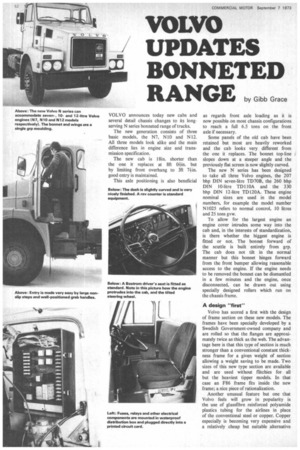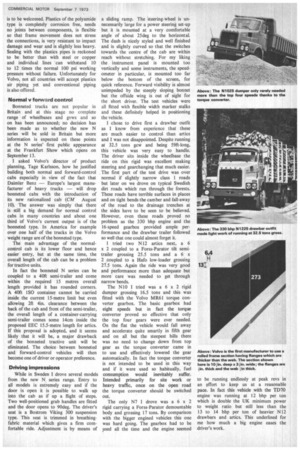VOLVO UPDATES BONNETED
Page 54

Page 55

If you've noticed an error in this article please click here to report it so we can fix it.
RANGE by Glib Grace
VOLVO announces today new cabs and several detail chassis changes to its longserving N series bonneted range of trucks_ The new generation consists of three basic models, the Ni, NIO and N12. All three models look alike and the main difference lies in engine size and transmission specification.
The new cab is 18in. shorter than the one it replaces at 8ft 0+in, but by limiting front overhang to 3ft 74-in. good entry is maintained.
This axle positioning is also beneficial as regards front axle loading as it is now possible-on most chassis configurations to reach a full 6.5 tons on the front axle if necessary.
Some panels of the old cab have been retained but most are heavily reworked and the cab looks very different from the one it replaces. The bonnet top-line I slopes down at a steeper angle and the previously flat screen is now slightly curved.
The new N series has been designed to take all three Volvo engines, the 207 bhp DIN seven-litre TD70B, the 260 bhp DIN 10-litre TD110A and the 330 bhp DIN 12-litre TD120A. These engine nominal sizes are used in the model numbers, for example the model number N1025 refers to normal control, 10 litres and 25 tons gvw.
To allow for the largest engine an engine cover intrudes some way into the cab and, in the interests of standardization, is there whether the biggest engine is fitted or not. The bonnet forward of the scuttle is built entirely from grp. The cab does not tilt in the normal manner but this bonnet hinges forward from the front bumper allowing reasonable access to the engine. If the engine needs to be removed the bonnet can be dismantled in a few minutes and the engine, once disconnected, can be drawn out using specially designed rollers which run on the chassis frame.
A design "first" Volvo has scored a first with the design of frame section on these new models. The frames have been specially developed by a Swedish Government-owned company and are rolled so that the flanges are approximately twice as thick as the web. The advantage here is that this type of section is much stronger than a conventional constant thickness frame for a given weight of section allowing a weight saving to be made. Two sizes of this new type section are available and are used without flitchies for all but the heaviest tipper models. In that case an F86 frame fits inside the new frame; a nice piece of rationalization.
Another unusual feature but one that Volvo feels will grow in popularity is the use of glassfibre reinforced polyamide plastics tubing for the airlines in place of the conventional steel or copper. Copper especially is becoming very expensive and a relatively cheap but suitable alternative is to be welcomed. Plastics of the polyamide type is completely corrosion free, needs no joints between components, is flexible so that frame movement does not stress the connections, is very resistant to impact damage and wear and is slightly less heavy. Sealing with the plastics pipes is reckoned to be better than with steel or copper and individual lines can withstand 10 to 12 times the normal 100 psi working pressure without failure. Unfortunately for Volvo, not all countries will accept plastics air piping yet and conventional piping is also offered.
Normal v forward control Bonneted trucks are not popular in Britain and at this stage no complete range of wheelbases and gvws and so on has been announced; no decision has been made as to whether the new N series will be sold in Britain but more information is expected on these points at the N series' first public appearance at the Frankfurt Show which opens on September 13.
I asked Volvo's director of product planning, Tage Karlsson, how he justified building both normal and forward-control cabs especially in view of the fact that Daimler Benz — Europe's largest manu facturer of heavy trucks — will drop
bonneted cabs with the introduction of its new rationalized cab (CM August
10). The answer was simply that there is still a big demand for normal control cabs in many countries and about one third of Volvo's current output is of the bonneted type. In America for example over one half of the trucks in the Volvo weight range are of the bonneted type.
The main advantage of the normalcontrol cab is its lower floor and hence easier entry, but at the same time, the overall length of the cab can be a problem for tractive units.
In fact the bonneted N series can be coupled to a 40ft semi-trailer and come within the required 15 metres overall length provided it has rounded corners. A 40ft ISO container cannot be carried inside the current I5-metre limit but even allowing 211 4in. clearance between the back of the cab and front of the semi-trailer, the overall length of a container-carrying semi-trailer comes some 14cm inside the proposed EEC 15.5-metre length for artics.
If this proposal is adopted, and it seems likely that it will be, a major drawback of the bonneted tractive unit will be eliminated. The choice between bonneted and forward-control vehicles will then become one of driver or operator preference.
Driving impressions While in Sweden I drove several models from the new N series range. Entry to all models is extremely easy and if the door is open it is possible to walk up into the cab as if up a flight of steps. Two well-positioned grab handles are fitted and the door opens to 90deg. The driver's seat is a Bostrom Viking 300 suspension type. This seat is trimmed in breathingfabric material which gives a firm comfortable ride. Adjustment is by means of a sliding ramp. The `steering-wheel is unnecessarily large for a power steering set-up but it is mounted at a very comfortable angle of about 25deg to the horizontal. The dash is nicely styled and well finished and is slightly curved so that the switches towards the centre of the cab are within reach without stretching. For my liking the instrument panel is mounted too vertically and some instruments, the speedometer in particular, is mounted too far below the bottom of the screen, for quick reference. Forward visibility is almost unimpeded by the steeply sloping bonnet but the offside wing is out of sight for the short driver. The test vehicles were all fitted with flexible width marker stalks and these definitely helped in positioning the vehicle.
I chose to drive first a drawbar outfit as I know from experience that these are much easier to control than artics and I was not disappointed. Despite running at 32.5 tons sew and being 59ft-long, this vehicle was very easy to handle. The driver sits inside the wheelbase the ride on this rigid was excellent making steering and gearchanging that much easier. The first part of the test drive was over normal if slightly narrow class I roads but later on we drove on typical Swedish dirt roads which run through the forests. These roads have terrible surfaces in places and on tight bends the camber and fall-away of the road to the drainage trenches at the sides have to be seen to be believed. However, even these roads proved no problem as the 330 bhp engine and the 16-speed gearbox provided ample performance and the drawbar trailer followed so well that one could almost forget it.
I tried two N12 artics next, a 6 x 2 coupled to a Forss-Parator tilt semitrailer grossing 25.5 tons and a 6 x 2 coupled to a Halo low-loader grossing 27.5 tons. Again the ride was very good and performance more than adequate but more care was needed to get through narrow bends.
The NIO I tried was a 6 x 2 rigid dumper grossing 16.5 tons and this was fitted with the Volvo MR61 torque converter gearbox. The basic gearbox had eight speeds but in fact the torque converter proved so effective that only the top four gears were ever needed. On the flat the vehicle would fall away and accelerate quite smartly in fifth gear and on all but the steepest hills there was no need to change down from top gear as the torque converter came in to use and effectively lowered the gear automatically. In fact the torque converter is not intended to be used in this way and if it were used so habitually, fuel consumption would inevitably suffer. Intended primarily for site work or heavy traffic, once on the open road the torque converter should be switched out.
The only N7 I drove was a 6 x 2 rigid carrying a Forss-Parator demountable body and grossing 17 tons. By comparison with the bigger engined vehicles this one was hard going. The gearbox had to be used all the time and the engine seemed to be running endlessly at peak revs in an effort to keep us at a reasonable pace. In fact this vehicle with the TD70 engine was running at 12 bhp per ton which is double the UK minimum power to weight ratio but still less than the 13 to 14 bhp per ton of heavier N12 drawbars and artics. This underlined for me how much a big engine eases the driver's work.








































































































































